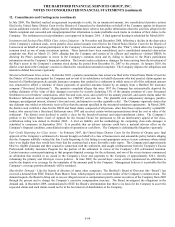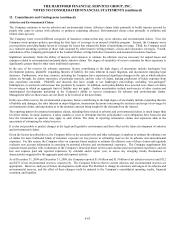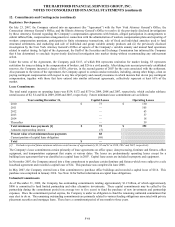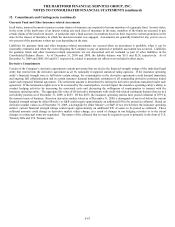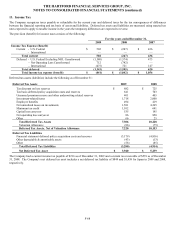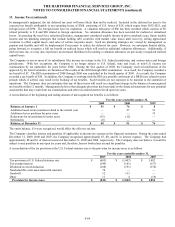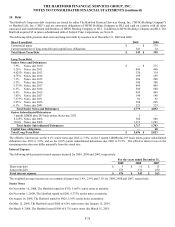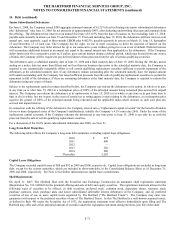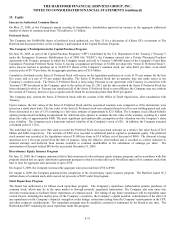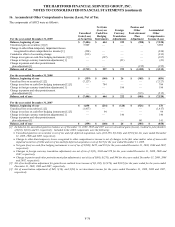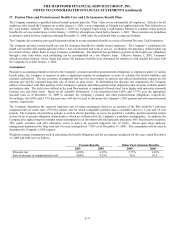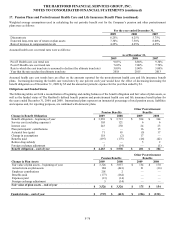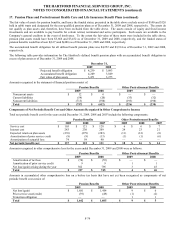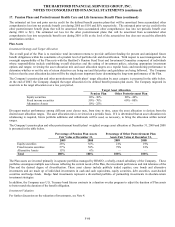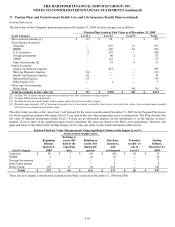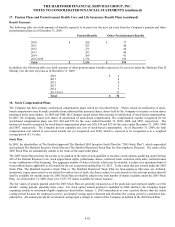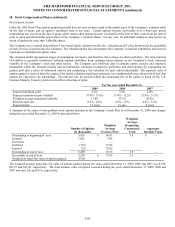The Hartford 2009 Annual Report Download - page 223
Download and view the complete annual report
Please find page 223 of the 2009 The Hartford annual report below. You can navigate through the pages in the report by either clicking on the pages listed below, or by using the keyword search tool below to find specific information within the annual report.
THE HARTFORD FINANCIAL SERVICES GROUP, INC.
NOTES TO CONSOLIDATED FINANCIAL STATEMENTS (continued)
F-74
15. Equity (continued)
Noncontrolling Interests
Noncontrolling interest includes VIEs in which the Company has concluded that it is the primary beneficiary, see Note 5 for further
discussion of the Company’ s involvement in VIEs, and general account mutual funds where the Company holds the majority interest
due to seed money investments. The Company records noncontrolling interest as a component of equity. The noncontrolling interest
within these entities is likely to change, as these entities represent investment vehicles whereby investors may frequently redeem or
contribute to these investments. As such, the change in noncontrolling ownership interest represented in the Company’ s Consolidated
Statement of Changes in Equity will primarily represent redemptions and additional subscriptions within these investment vehicles.
Statutory Results (unaudited)
The domestic insurance subsidiaries of The Hartford prepare their statutory financial statements in conformity with statutory accounting
practices prescribed or permitted by the applicable state insurance department which vary materially from U.S. GAAP. Prescribed
statutory accounting practices include publications of the National Association of Insurance Commissioners (“NAIC”), as well as state
laws, regulations and general administrative rules. The differences between statutory financial statements and financial statements
prepared in accordance with U.S. GAAP vary between domestic and foreign jurisdictions. The principal differences are that statutory
financial statements do not reflect deferred policy acquisition costs and limit deferred income taxes, life benefit reserves predominately
use interest rate and mortality assumptions prescribed by the NAIC, bonds are generally carried at amortized cost and reinsurance assets
and liabilities are presented net of reinsurance.
The statutory net income (loss) amounts for the years ended December 31, 2008 and 2007, and the statutory surplus amounts as of
December 31, 2008 and 2007 in the table below are based on actual statutory filings with the applicable U.S. regulatory authorities. The
statutory net income amounts for the year ended December 31, 2009 and the statutory surplus amounts as of December 31, 2009 are
estimates, as the respective 2009 statutory filings have not yet been made.
Statutory Net Income (Loss) For the years ended December 31,
2009 2008 2007
Life operations $1,928 $ (4,553) $729
Property & Casualty operations 889 497 1,803
Total $2,817 $ (4,056) $2,532
Statutory Surplus As of December 31,
2009 2008
Life Operations, includes domestic captive insurance subsidiaries $ 7,287 $6,046
Property & Casualty Operations, excluding non-Property & Casualty subsidiaries 7,364 6,012
Total $ 14,651 $12,058
The Company also holds regulatory capital and surplus for its operations in Japan. Using the investment in subsidiary accounting
requirements defined in the U.S. National Association of Insurance Commissioners Statements of Statutory Accounting Practices, the
Company’ s statutory capital and surplus attributed to the Japan operations was $1,311 and $1,718 as of December 31, 2009 and 2008,
respectively.
The Company received approval from the Connecticut Insurance Department regarding the use of two permitted practices in the
statutory financial statements of its Connecticut-domiciled life insurance subsidiaries as of December 31, 2008. The first permitted
practice related to the statutory accounting for deferred income taxes. Specifically, this permitted practice modified the accounting for
deferred income taxes prescribed by the NAIC by increasing the realization period for deferred tax assets from one year to three years
and increasing the asset recognition limit from 10% to 15% of adjusted statutory capital and surplus. The benefits of this permitted
practice were not considered by the Company when determining surplus available for dividends. The second permitted practice related
to the statutory reserving requirements for variable annuities with guaranteed living benefit riders. Actuarial guidelines prescribed by
the NAIC required a stand-alone asset adequacy analysis reflecting only benefits, expenses and charges that are associated with the
riders for variable annuities with guaranteed living benefits. The permitted practice allowed for all benefits, expenses and charges
associated with the variable annuity contract to be reflected in the stand-alone asset adequacy test. These permitted practices resulted in
an increase to Life operations statutory surplus of $987 as of December 31, 2008. The effects of these permitted practices were included
in the 2008 Life operations surplus amount in the table above.
In December, 2009 the NAIC issued SSAP 10R which codified the three year realization period and 15% of adjusted statutory capital
and surplus recognition limits for accounting for deferred tax assets for both life and property and casualty companies. SSAP 10R will
expire for periods after December 31, 2010.


